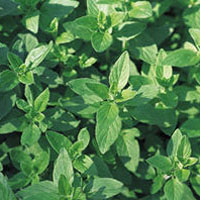
A-Z Indexes Food Health Guides
Health News |
Oregano/Wild MarjoramFind ProductsAlso indexed as:Origanum vulgare, Marjoram (Wild), Oreganol  © Martin Wall © Martin WallBotanical names: Origanum vulgareHow It WorksThis dried herb contains several constituents, including volatile oil (up to 3%), such as carvacrol, thymol, and borneol, plus flavonoids, rosmarinic acid, triterpenoids (e.g. ursolic and oleanolic acid), sterols, and vitamin A and vitamin C.4 The thymol and carvacrol contents in oregano are responsible for its antimicrobial and antifungal effects.5 A test tube study demonstrated that oil of oregano, and carvacrol in particular, inhibited the growth of Candida albicans far more effectively than a commonly employed antifungal agent called calcium magnesium caprylate.6 Clinical studies are still needed to confirm these actions in humans. In addition to its anti-fungal action, and according to the results of another test tube study from Australia, oregano oil has a strong anti-microbial action against a wide number of bacteria, including Escherichia coli, Klebsiella pneumoniae, Salmonella enterica, and Staphylococcus aureus.7 Other test tube studies have shown that oregano from the Mexican (Lippia) species was more effective than the prescription medication tinidazol in inhibiting the parasite giardia (Giardia duodenalis).8 In another test tube study, volatile oils of oregano, thyme, cinnamon, and cumin were individually able to stop the growth of another food-borne pathogen called Aspergillus parasiticus. Higher concentrations of these volatile oils were also able to stop the production of aflatoxin, a potent poison from the food moldAspergillus.9 Together these facts suggest the volatile oils in oregano used during food processing have an important role in preventing the spoilage of food and in reducing the risk of ingesting harmful bacteria, fungi, and parasites. Again, these actions have not yet been confirmed by human clinical trials. The German Commission E does not approve oregano for any medical indication.10 How to Use ItDried or fresh leaf of oregano can be made into a tea by steeping 1 to 2 teaspoons (5 to 10 grams) in hot water for ten minutes. This tea can be consumed three times a day.11 The oil (50% or greater dilution) may be applied topically twice a day to areas affected by athlete’s foot or other fungal infections. The affected area should be covered by the oil with each application. The safety of the internal use of the oil has not been well studied and should be used with caution or after consulting with a healthcare professional. Copyright © 2025 TraceGains, Inc. All rights reserved. Learn more about TraceGains, the company. The information presented by TraceGains is for informational purposes only. It is based on scientific studies (human, animal, or in vitro), clinical experience, or traditional usage as cited in each article. The results reported may not necessarily occur in all individuals. Self-treatment is not recommended for life-threatening conditions that require medical treatment under a doctor's care. For many of the conditions discussed, treatment with prescription or over the counter medication is also available. Consult your doctor, practitioner, and/or pharmacist for any health problem and before using any supplements or before making any changes in prescribed medications. Information expires December 2025. |
